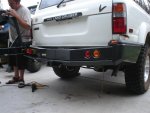KG6BWS
Explorer
The problem in most cases is not the spindle but the design of the carrier and the latching mechanism that allows excessive movement in the carrier. This is a common mistake in DIY systems as well as the overloading, to big carrier situation.
thats what i was going to say. the picture of the broken rocklogic hinge is exactly what happened to mine. broke in exactly the same spot. where i screwed up was on the other end of the carrier i didnt brace it enough. it allowed the carrier to vibrate and bounce so badly that it fatigued the spindle until it broke. when i redesigned it i just braced the latch end so that the carrier had no movement whatsoever when it was latched.
and if you build your own ADD A SAFETY PIN!!!!!!!! the only thing that kept my spare, hilift and 10 gallons of gas from going thru the windshield of a minivan behind me was a safety pin i made out of 1/2" round bar that went thru the carrier and then thru the bumper with a cotter key underneath to keep it from bouncing out.









